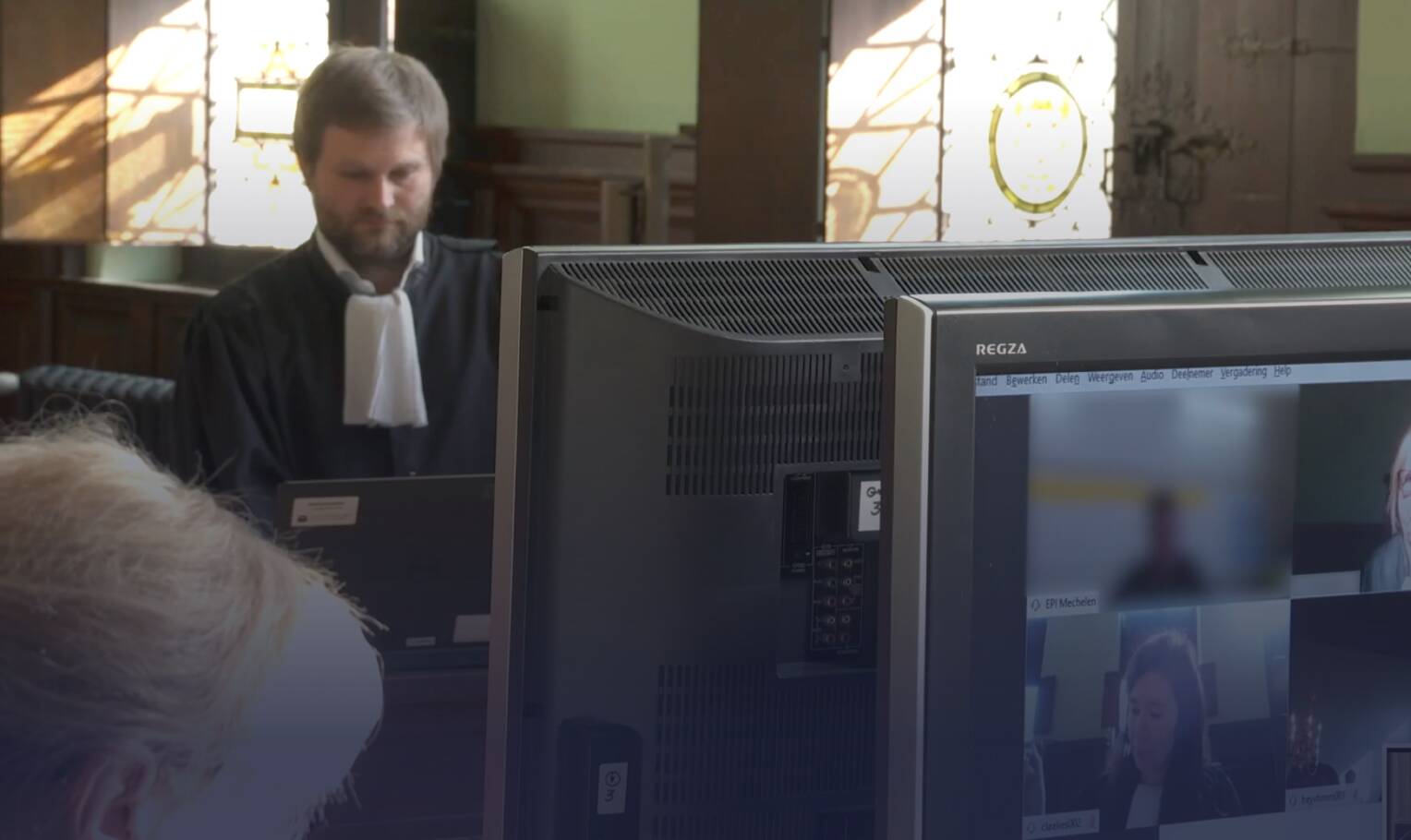How technology keeps cities livable and makes them smarter
URBAN DEVELOPMENT
Data from various sources form the basis for a smart policy to increase the quality of life in cities.

Discover the stories of ASAsense, Schréder
and Crammerock
Measuring is knowing: sensors on the road, smart lighting in the city and IoT on the festival site.
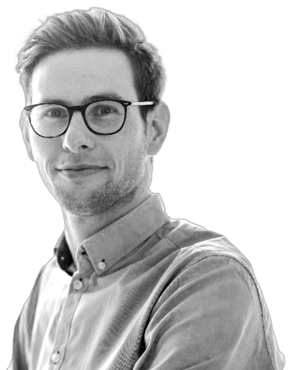

Evert Gellynck,
Traffic engineer at Be-Mobile
“TRAFFIC MANAGEMENT-AS-A-SERVICE ADAPTS MOBILITY DATA TO THE SITUATION OF THE USER.”
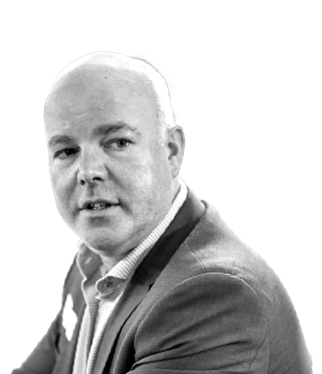

Johan Geleyns,
Alderman for sport, trade and employment of the city of Leuven
“USING DATA ANALYTICS AS A BASIS, WE WILL REFINE OUR EFFORTS AROUND CITY MARKETING.”
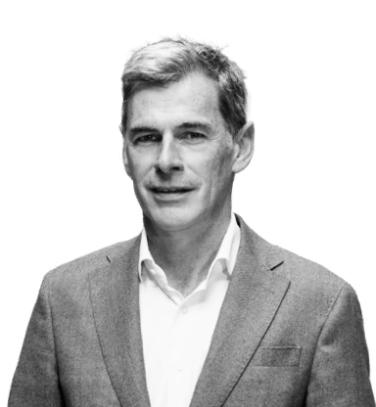

Peter De Durpel,
COO Nextensa
“INCLUSIVENESS AND CIRCULARITY ARE KEYWORDS WITHIN THE TOUR & TAXIS PROJECT.”


CONNECTING WITH THE PAST
The authenticity is expressed in the redevelopment of heritage gems like the Entrepôt Royal and Maison de la Poste. The recently completed renovation of the Gare Maritime is an absolute eye-catcher. What was once known as the largest freight station in Europe, Nextensa transformed into an inspiring biotope for co-creation-based businesses, a food hall, bars, markets, terraces and unconventional shops. “We make sure there is a connection with the historic layout and materials of the station building. Good examples are the nave with its original cobblestones and the preservation of the fourteen original side entrances,” De Durpel explained.
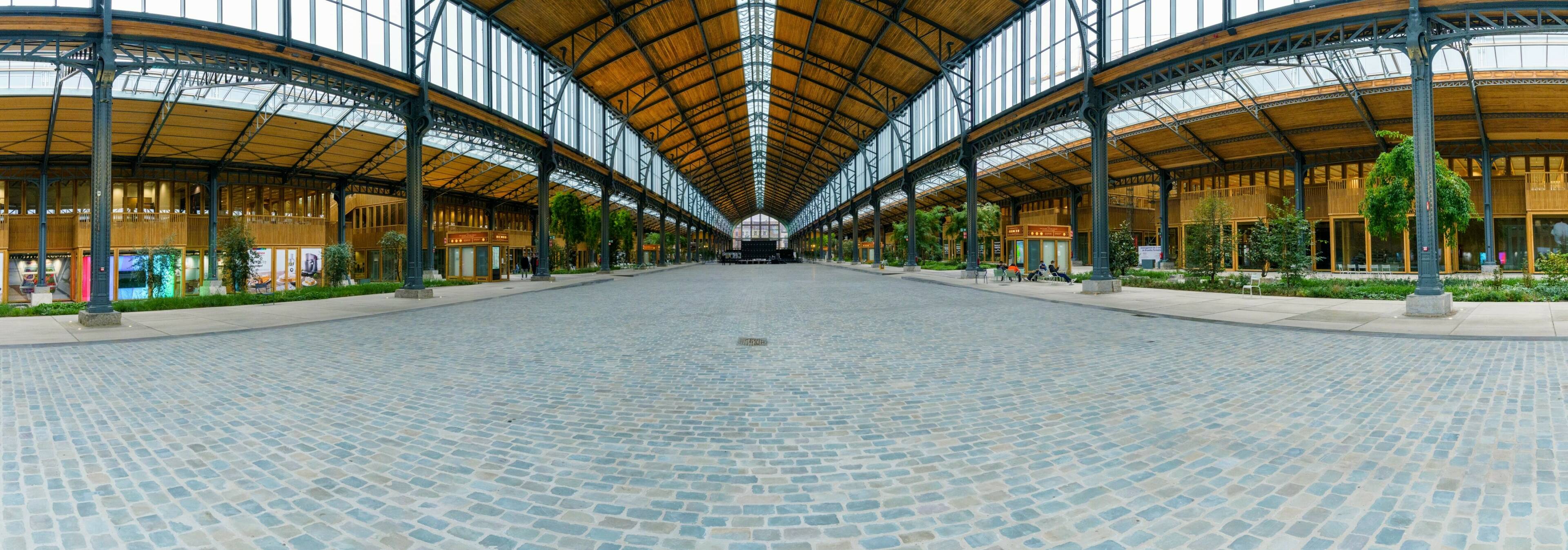
From the beginning of the last century, Tour & Taxis functioned as a logistics platform for customs with a central goods station and warehouses. It thus contributed to the Belgian economic boom. "In the sixties, there were still around 5,000 people working at Tour & Taxis. When goods transport shifted from trains to trucks and customs lost its importance, the site lost its initial purpose," explains Peter De Durpel. Property developer Nextensa bought the site in 2000 along with some partners and has been the sole owner since 2015.
Tour & Taxis
Tour & Taxis becomes a vibrant city hub
The Tour & Taxis site is emerging as a vibrant city hub, where living, working and relaxing go hand in hand. Peter De Durpel, COO of owner Nextensa, explains how the project gives Brussels a new dynamism.
BALANCED MIX
The challenge for Nextensa was to develop the site into a balanced mix of offices, residential units, retail, green and leisure facilities. Buildings of a high architectural standard were given a new function. "Inclusiveness, authenticity and circularity are important keywords," explains Peter De Durpel. "This part of town should appeal to everyone, and that includes affordable housing – in total we are creating around 1,800 homes – and space for offices, retail, hospitality and events that offer something for everyone."
SUSTAINABILITY
Nextensa puts sustainability first. “The landscaping with the park, the pond and the space between the buildings is as important as the development of the buildings themselves,” said De Durpel.
Once the project is completed, Tour & Taxis will have nine hectares of park area at its disposal. But there is plenty of green too in the indoor areas. For example, the green boulevards in the Gare Maritime are lined with themed gardens and tall trees on either side of the nave. The building generates its own energy from renewable sources, using geothermal energy and solar panels. Two gigantic rainwater tanks make it possible to store 1.4 million liters of water, while the excess rainwater flows directly into the canal.
COLLECT INTERESTING DATA AND IMPROVE YOUR PROCESSES
Peter De Durpel
COO Nextensa
“INCLUSIVENESS, AUTHENTICITY AND CIRCULARITY ARE IMPORTANT KEYWORDS WITHIN THE TOUR & TAXIS PROJECT.”
Peter De Durpel, COO Nextensa
“The urban renewal project on the Tour & Taxis site also has a technological dimension. The Proximus fiber network forms the basis for this.”
TECHNOLOGY WITHIN A HISTORICAL FRAMEWORK
The urban renewal project on the Tour & Taxis site also has a technological dimension. “We defined our technological needs and wishes in cooperation with Proximus. This resulted in a fiber network that reaches the site through two entrances, thus ensuring speed, redundancy and connectivity. Visitors use our public Wi-Fi network in public areas, which we can easily scale up if there are large-scale events. In addition, we have a smart camera network, which contributes to site security and combined with the Wi-Fi network, allows us to capture visitor movements and call up heatmaps."
Completion of this groundbreaking urban renewal project is planned in six to eight years’ time. "It is a story that – just like the city itself – is constantly evolving and in motion," De Durpel concluded.
Nextensa
Real estate developer Extensa and real estate investor Leasinvest Real Estate – both of which have been (partly) under the umbrella of investment company Ackermans & van Haaren since the 1990s – recently merged to become Nextensa. The company specializes in real estate developments and investments with a strong focus on sustainability.

Peter De Durpel
graduated as a civil engineer from the Royal Military Academy, Department of Polytechnics. Since 2015, he has been responsible for the operational part at Nextensa as COO.


DISCOVER HOW WE CAN MAKE YOUR SERVICE AND work environment SMARTER
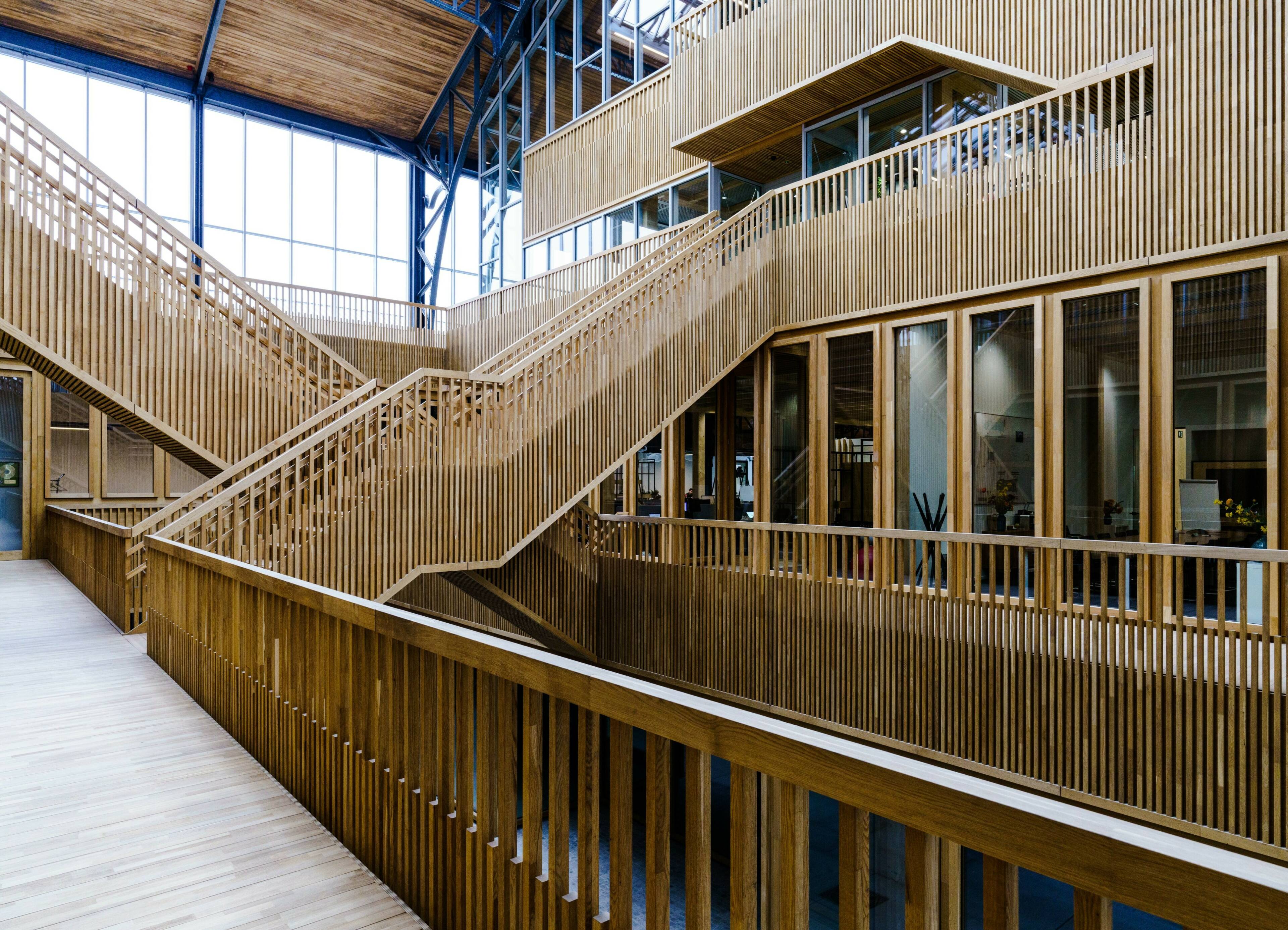

COLLECT INTERESTING DATA AND IMPROVE YOUR PROCESSES
DISCOVER HOW WE CAN MAKE YOUR SERVICE AND WORK ENVIRONMENT SMARTER

Johan Geleyns
Alderman for sport, trade and employment of the city of Leuven
“Shopkeepers can check the information about how busy the city is against the results they themselves have achieved. This allows them to estimate staffing levels.”
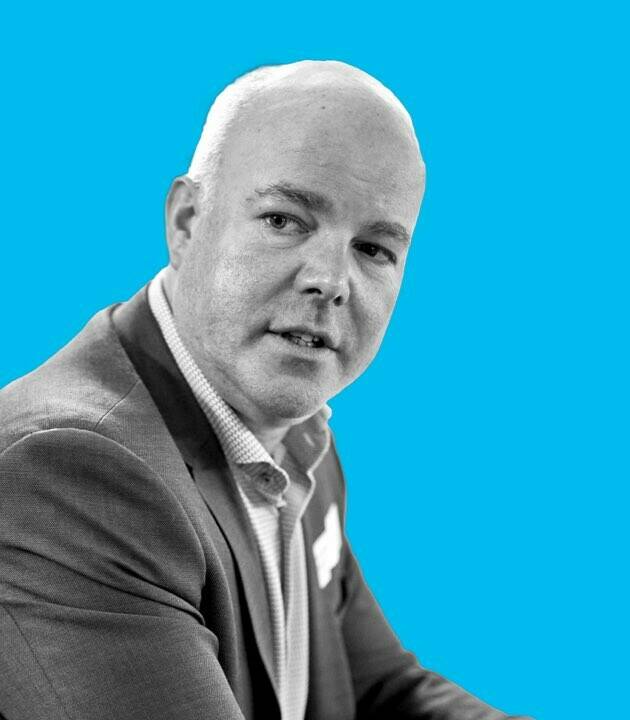
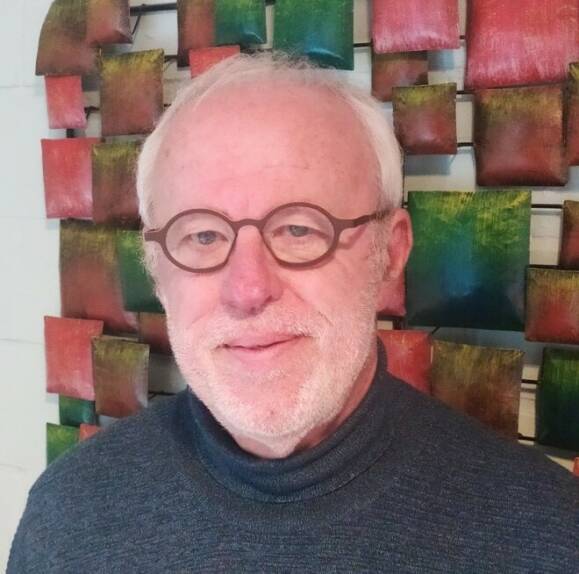
Michel Warlop
Projectmanager at the city of Leuven.
"WE HAVE NO WAY OF GETTING TO THE SOURCE DATA OURSELVES. PRIVACY AND DATA PROTECTION ARE VERY IMPORTANT TO THE CITY"
Johan Geleyns
Alderman for sport, trade and employment of the city of Leuven
“using data analytics as a basis, we will refine our efforts around city marketing. We can now do very targeted campaigning.”
TARGETED CITY MARKETING
One example of a major event was the world cycling championship that came to Leuven in September. "Thanks to data analytics, we have a good picture of the visitors from home and abroad in Leuven at the time," said Geleyns. "With that information, we will further refine our policies around city marketing. For example, we can campaign very specifically for Leuven as a destination in specific countries, or promote Leuven as a shopping city in certain regions in our own country."
By combining this with other data – for example on mobility or socio-economic background – Leuven can further develop into a truly smart city. "We are working on a dashboard for shopkeepers, following the example of cities such as Antwerp, Mechelen and Roeselare," says Helena Schulpé, Smart City project coordinator at the city of Leuven. "A dashboard like that combines the pressure measurement with information about customer profiles and spending amounts. With data analytics, we already have a good basis to work on further."
INFORMATION FOR ENTREPRENEURS AND LOCAL BUSINESSES
The availability of the data provides the city with fresh, new insights. "We started the process in early 2020," said Geleyns. "This has allowed us clearly to see the impact of COVID in our numbers, but also of the resumption of the economy." The city, therefore, also wants to make the information available to businesses in Leuven. For example, information about how busy specific areas are can be important in order to plant an office or shop in the appropriate location.
Geleyns: "Shopkeepers can check the information about how busy the city is against the results they themselves have achieved. This allows them – for example for the next edition of an event – to estimate staffing levels, required supplies, etc. better. Thanks to the information about the origin of the visitors, shopkeepers can focus their advertising efforts on the right regions."
DYNAMIC DASHBOARD
Data analytics detects in real time how many people are within a certain zone. At the core are the mobile phones on the Proximus network, which constantly transmit location information. The analysis is done at the level of cell phone towers and with anonymous and aggregated data from groups of more than 30 people. Proximus delivers the information via a dynamic dashboard. "We have no way of getting to the source data ourselves," says Michel Warlop, project manager at the city of Leuven. Privacy and data protection are very important to the city. "We tested all of that properly before we started working with data analytics," said Geleyns.
Specifically, the solution measures how long a person is within a certain zone. That allows us to determine whether …
- Someone is running a quick errand (less than half an hour).
- Someone is spending a long time shopping (a whole day)
- Someone is staying over
"We also see which countries foreign visitors come from," Warlop explained.
- Belgian visitors are classified by province.
- We only use the most detailed information – down to the level of the sub-boroughs – about visitors from the immediate region, some twelve miles or twenty kilometers around Leuven.
city of Leuven
Leuven gets to know its visitors better with the help of data analytics
Data analytics not only give Leuven an overview of how busy the city is but also where visitors come from. This allows local businesses, among others, but also the city itself, to conduct very targeted campaigns.
Measuring is knowing. That is why Leuven started counting passers-by at fixed points in the city's main shopping streets over fifteen years ago. For some years now, however, the evolution of ICT technology and resources has offered the possibility of a much richer picture.
“Counting passers-by gives you an idea of how busy it is, but not much more than that," says Johan Geleyns, alderman for sport, trade and employment at the city of Leuven. "Thanks to data analytics from Proximus we are gaining more insight. We get a clearer picture of crowds, not at one fixed point, but within wider zones in the city. In addition, we now know the origin of visitors in our city."
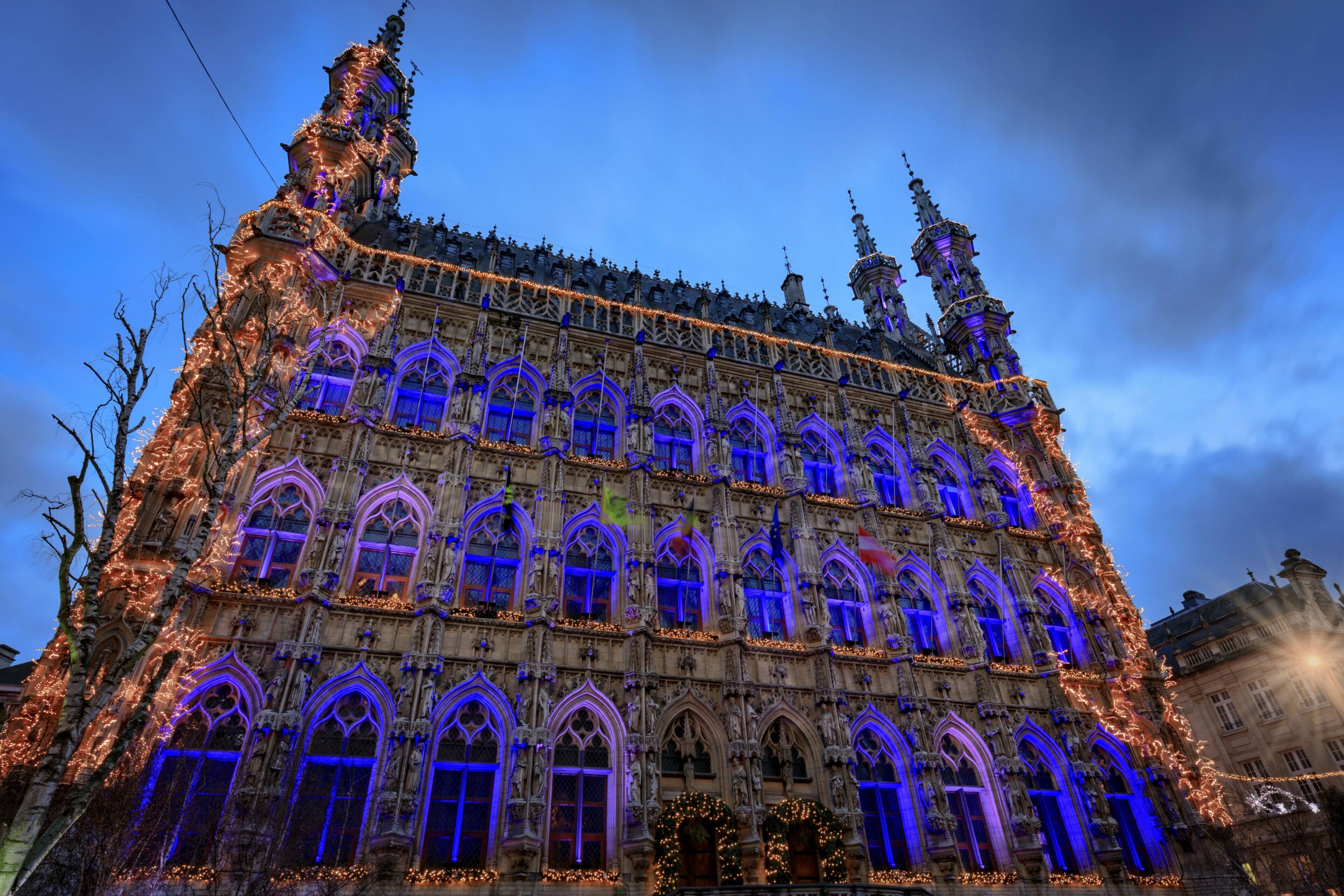


Evert Gellynck
is a traffic engineer at Be-Mobile.
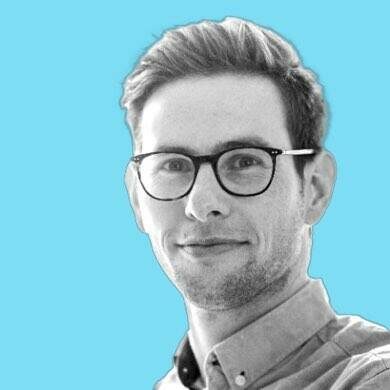
Tim Claeys
is an employee of the Ghent Traffic Center.

Filip Watteeuw
is alderman for mobility, public space and urban development in the city of Ghent.
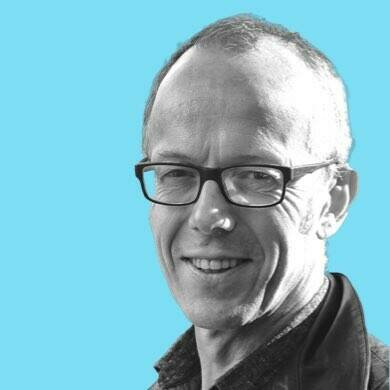
COLLECT INTERESTING DATA AND IMPROVE YOUR PROCESSES
DISCOVER HOW WE CAN MAKE YOUR SERVICE AND WORk ENVIRONMENT SMARTER

Personalized traffic information
PROACTIVE TRAFFIC FOLLOW-UP
“Follow-up of traffic is our core task,” says Tim Claeys of the Ghent Traffic Center (Verkeerscentrum Gent). “We do that proactively insofar as possible, for example by steering traffic through regulation of the traffic lights and dynamic information signs depending on roadworks or events. Sometimes, of course, we also have to intervene in real time, for example when there is a traffic accident.” Generally speaking, a lot of traffic data are available. This includes not just data from the traffic center, but also data from parking companies, bicycle and car sharing companies, De Lijn and SNCB, companies such as TomTom and Be-Mobile, and so forth. “That makes the project unique,” Filip Watteeuw, alderman for mobility in Ghent, believes. “TMaaS brings together large and small companies from all sectors on mobility. Competitors work together on a project that brings out the best in everyone.”
TMaaS brings all that mobility data together in the cloud and bundles it into usable information. “TMaaS feeds our digital dashboard LINK.Gent.” explains Tim Claeys. “The dashboard provides up-to-date traffic information in real time.” In addition, the information is multimodal. While most mobility platforms primarily give information for car drivers, LINK.Gent also offers information for pedestrians, cyclists and train, tram and bus users. “The user can adapt the dashboard to his personal situation,” says Evert Gellynck, traffic engineer at Be-Mobile. “For example, you can plot out your regular route to work on the platform. Depending on your mode of transportation, you then receive personalized alerts.”
Be-Mobile
Data support Ghent in mobility management
Ghent is committed to a modal shift, making transport more sustainable. The goal: to improve the quality of life for residents and businesses. Traffic Management as a Service supports that policy by offering a new generation of tools for traffic management.
Be-Mobile has set up a digital platform for Ghent together with other partners from the Traffic Management-as-a-Service consortium. The city uses it to process traffic data and monitor traffic information in real time. The platform brings together as much of the available mobility data as possible. Analysis of that data provides useful information, both for those who manage mobility in a city and for the citizens and businesses counting on that mobility.


“The dozens of IoT sensors are as accurate as those of expensive high-tech road inspection systems.”
Thomas Weyn,
Ceo of ASAsense
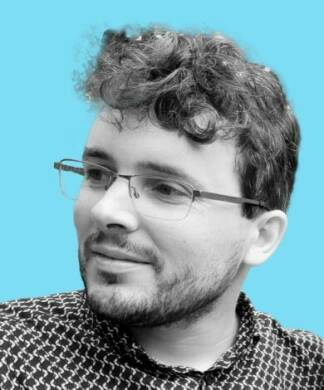
ASAsense is a spin-off from Ghent University. Their initial focus was on smart noise meters. With Roads, they developed sensor units that cities and towns use to measure the noise and vibrations of the road surface in order to improve the quality of their roads.

Discover the whole story
Case ASAsense
IoT sensors measure road surface quality
ASAsense’s CEO Thomas Weyn: "Cities and municipalities generally have too few resources or tools at their disposal to monitor the quality of their roads. ASAsense developed 'Roads': sensor units that allow cities and towns to monitor the quality of their roads in real time and at a low cost.
Thomas Weyn: “The laser scanners and Close Proximity (CPX) trailers used by the federal government and the regions are unaffordable for cities and municipalities. They also require a constant deployment of two people driving around with the trucks. Cities and towns now rely on complaints from their residents and visual inspections by personnel seldom trained to recognize deteriorating roads.”
"The idea of a small, low-cost IoT version of the CPX measurements was already there. The technology was developed in the MobiSense project that included UGent, University of Antwerp, KU Leuven, Be-Mobile and Qweriu. In addition to noise, we also wanted to measure vibrations and know exactly where there were problems with the road surface. When the research project ended, we refined the sensor units even further with ASAsense.”

COLLECT INTERESTING DATA AND IMPROVE YOUR PROCESSES
DISCOVER HOW WE CAN MAKE YOUR SERVICE AND WORK ENVIRONMENT SMARTER


Case Crammerock
A safe and accessible festival thanks to IoT
Discover the whole setup
The music festival Crammerock attracts 35,000 visitors yearly to Stekene. The organizers use various technologies to ensure that the event runs smoothly and safely.
Anthony De Block is logistics manager. ‘Measuring is knowing’, is the motto of the electromechanics engineer. “Many parameters contribute to a successful and safe festival. If data can help you monitor and optimize processes, you should embrace it.” The organizers first mapped out where technology could benefit them. “Aspects such as CO2 concentration and pressure measurement were a priority in times of COVID, but the wind speed and toilet use also offered the necessary potential,” says Anthony De Block.

Read more
Case Schréder
Smartly controlled public lighting
Schréder, a smart lighting specialist and Codit, an expert in Microsoft Azure, co-developed the new online platform Exedra. This platform allows Schréder customers to manage their own smart lighting data personally.
For many government and town council offices, public lighting is a challenge. Liège-based Schréder’s smart lighting provides a solution to that issue. Schréder’s Jean-Jacques van Gils: “Our aim is to provide solutions in the form of apps, for example, that facilitate better, optimized customer-driven management of public lighting.
Schréder’s smart lighting works with sensors that record temperature, traffic density, or weather conditions. Those sensors then send their data to the online Exedra platform. Customers can use the application to analyze, control, and manage all the data in order to maximize their lighting network’s efficiency. The platform is a Codit solution.
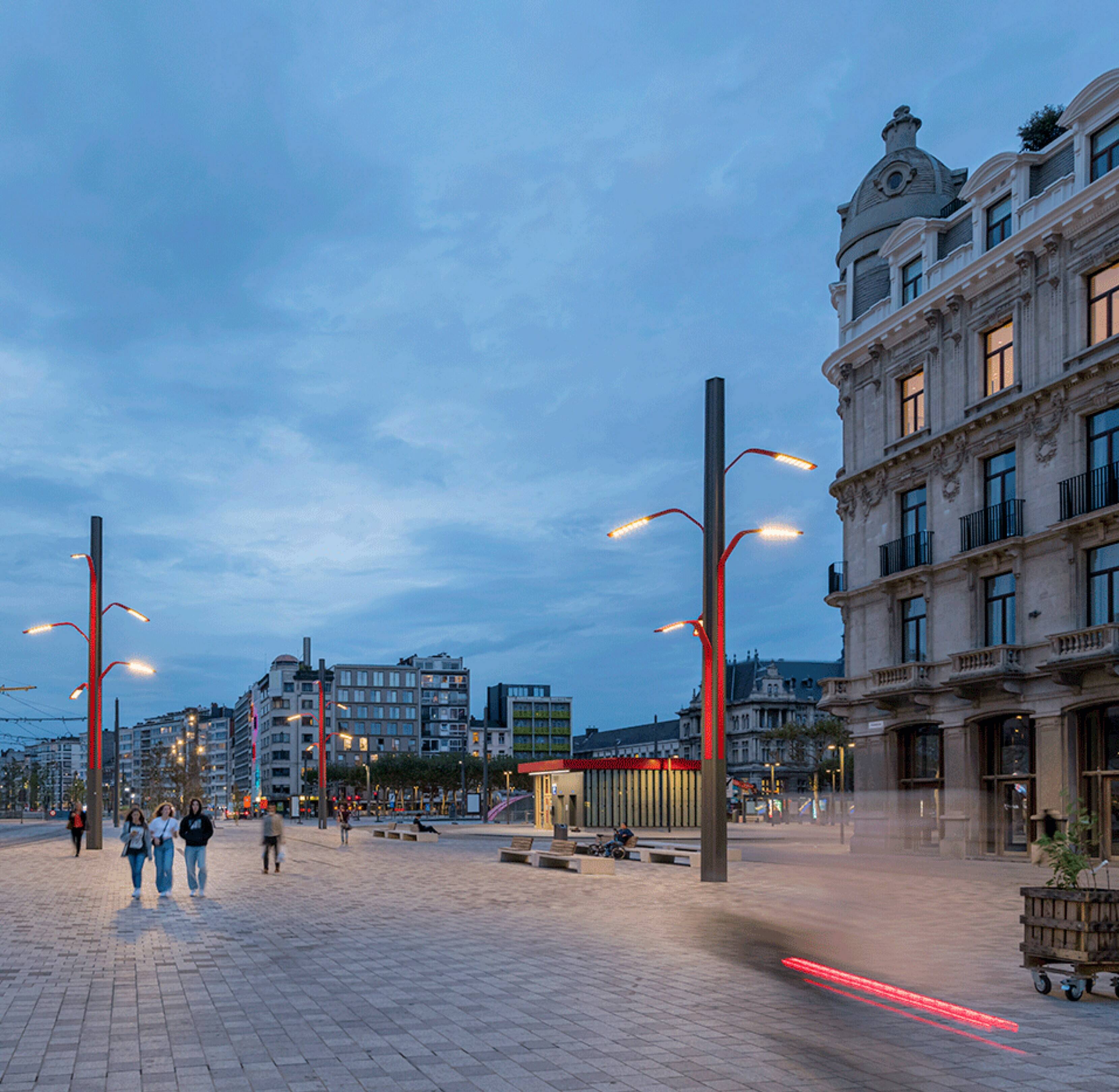
Data from various sources form the basis for a smart policy to increase the quality of life in cities.
How technology keeps cities livable and makes them smarter
URBAN DEVELOPMENT

SUSTAINABILITY
Nextensa puts sustainability first. “The landscaping with the park, the pond and the space between the buildings is as important as the development of the buildings themselves,” said De Durpel.
Once the project is completed, Tour & Taxis will have nine hectares of park area at its disposal. But there is plenty of green too in the indoor areas. For example, the green boulevards in the Gare Maritime are lined with themed gardens and tall trees on either side of the nave. The building generates its own energy from renewable sources, using geothermal energy and solar panels. Two gigantic rainwater tanks make it possible to store 1.4 million liters of water, while the excess rainwater flows directly into the canal.
Nextensa
Real estate developer Extensa and real estate investor Leasinvest Real Estate – both of which have been (partly) under the umbrella of investment company Ackermans & van Haaren since the 1990s – recently merged to become Nextensa. The company specializes in real estate developments and investments with a strong focus on sustainability.

TECHNOLOGY WITHIN A HISTORICAL FRAMEWORK
The urban renewal project on the Tour & Taxis site also has a technological dimension. “We defined our technological needs and wishes in cooperation with Proximus. This resulted in a fiber network that reaches the site through two entrances, thus ensuring speed, redundancy and connectivity. Visitors use our public Wi-Fi network in public areas, which we can easily scale up if there are large-scale events. In addition, we have a smart camera network, which contributes to site security and combined with the Wi-Fi network, allows us to capture visitor movements and call up heatmaps."
Completion of this groundbreaking urban renewal project is planned in six to eight years’ time. "It is a story that – just like the city itself – is constantly evolving and in motion," De Durpel concluded.
Peter De Durpel, COO Nextensa
“The urban renewal project on the Tour & Taxis site also has a technological dimension. The Proximus fiber network forms the basis for this.”
Peter De Durpel
COO Nextensa
“INCLUSIVENESS, AUTHENTICITY AND CIRCULARITY ARE IMPORTANT KEYWORDS WITHIN THE TOUR & TAXIS PROJECT.”
CONNECTING WITH THE PAST
The authenticity is expressed in the redevelopment of heritage gems like the Entrepôt Royal and Maison de la Poste. The recently completed renovation of the Gare Maritime is an absolute eye-catcher. What was once known as the largest freight station in Europe, Nextensa transformed into an inspiring biotope for co-creation-based businesses, a food hall, bars, markets, terraces and unconventional shops. “We make sure there is a connection with the historic layout and materials of the station building. Good examples are the nave with its original cobblestones and the preservation of the fourteen original side entrances,” De Durpel explained.
BALANCED MIX
The challenge for Nextensa was to develop the site into a balanced mix of offices, residential units, retail, green and leisure facilities. Buildings of a high architectural standard were given a new function. "Inclusiveness, authenticity and circularity are important keywords," explains Peter De Durpel. "This part of town should appeal to everyone, and that includes affordable housing – in total we are creating around 1,800 homes – and space for offices, retail, hospitality and events that offer something for everyone."
Peter De Durpel
graduated as a civil engineer from the Royal Military Academy, Department of Polytechnics. Since 2015, he has been responsible for the operational part at Nextensa as COO.

From the beginning of the last century, Tour & Taxis functioned as a logistics platform for customs with a central goods station and warehouses. It thus contributed to the Belgian economic boom. "In the sixties, there were still around 5,000 people working at Tour & Taxis. When goods transport shifted from trains to trucks and customs lost its importance, the site lost its initial purpose," explains Peter De Durpel. Property developer Nextensa bought the site in 2000 along with some partners and has been the sole owner since 2015.
Tour & Taxis
Tour & Taxis becomes a vibrant city hub
The Tour & Taxis site is emerging as a vibrant city hub, where living, working and relaxing go hand in hand. Peter De Durpel, COO of owner Nextensa, explains how the project gives Brussels a new dynamism.


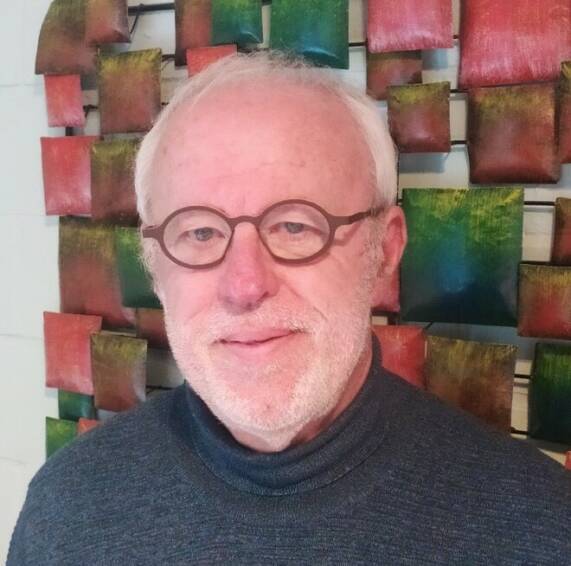
Michel Warlop
Projectmanager at the city of Leuven.
"WE HAVE NO WAY OF GETTING TO THE SOURCE DATA OURSELVES. PRIVACY AND DATA PROTECTION ARE VERY IMPORTANT TO THE CITY"
DISCOVER HOW WE CAN MAKE YOUR SERVICE AND WORK ENVIRONMENT SMARTER
COLLECT INTERESTING DATA AND IMPROVE YOUR PROCESSES

TARGETED CITY MARKETING
One example of a major event was the world cycling championship that came to Leuven in September. "Thanks to data analytics, we have a good picture of the visitors from home and abroad in Leuven at the time," said Geleyns. "With that information, we will further refine our policies around city marketing. For example, we can campaign very specifically for Leuven as a destination in specific countries, or promote Leuven as a shopping city in certain regions in our own country."
By combining this with other data – for example on mobility or socio-economic background – Leuven can further develop into a truly smart city. "We are working on a dashboard for shopkeepers, following the example of cities such as Antwerp, Mechelen and Roeselare," says Helena Schulpé, Smart City project coordinator at the city of Leuven. "A dashboard like that combines the pressure measurement with information about customer profiles and spending amounts. With data analytics, we already have a good basis to work on further."
INFORMATION FOR ENTREPRENEURS AND LOCAL BUSINESSES
The availability of the data provides the city with fresh, new insights. "We started the process in early 2020," said Geleyns. "This has allowed us clearly to see the impact of COVID in our numbers, but also of the resumption of the economy." The city, therefore, also wants to make the information available to businesses in Leuven. For example, information about how busy specific areas are can be important in order to plant an office or shop in the appropriate location.
Geleyns: "Shopkeepers can check the information about how busy the city is against the results they themselves have achieved. This allows them – for example for the next edition of an event – to estimate staffing levels, required supplies, etc. better. Thanks to the information about the origin of the visitors, shopkeepers can focus their advertising efforts on the right regions."
Johan Geleyns
Alderman for sport, trade and employment of the city of Leuven
“using data analytics as a basis, we will refine our efforts around city marketing. We can now do very targeted campaigning.”
Peter De Durpel, COO Nextensa
“Het stadsvernieuwingsproject op de site van Tour & Taxis kent ook een technologische dimensie. Het fibernetwerk van Proximus vormt daarvoor de basis.”
Dynamisch dashboard
Data analytics detects in real time how many people are within a certain zone. At the core are the mobile phones on the Proximus network, which constantly transmit location information. The analysis is done at the level of cell phone towers and with anonymous and aggregated data from groups of more than 30 people. Proximus delivers the information via a dynamic dashboard. "We have no way of getting to the source data ourselves," says Michel Warlop, project manager at the city of Leuven. Privacy and data protection are very important to the city. "We tested all of that properly before we started working with data analytics," said Geleyns.
Specifically, the solution measures how long a person is within a certain zone. That allows us to determine whether …
- Someone is running a quick errand (less than half an hour).
- Someone is spending a long time shopping (a whole day)
- Someone is staying over
"We also see which countries foreign visitors come from," Warlop explained.
- Belgian visitors are classified by province.
- We only use the most detailed information – down to the level of the sub-boroughs – about visitors from the immediate region, some twelve miles or twenty kilometers around Leuven.
Johan Geleyns
Alderman for sport, trade and employment of the city of Leuven
“Shopkeepers can check the information about how busy the city is against the results they themselves have achieved. This allows them to estimate staffing levels.”

Measuring is knowing. That is why Leuven started counting passers-by at fixed points in the city's main shopping streets over fifteen years ago. For some years now, however, the evolution of ICT technology and resources has offered the possibility of a much richer picture.
“Counting passers-by gives you an idea of how busy it is, but not much more than that," says Johan Geleyns, alderman for sport, trade and employment at the city of Leuven. "Thanks to data analytics from Proximus we are gaining more insight. We get a clearer picture of crowds, not at one fixed point, but within wider zones in the city. In addition, we now know the origin of visitors in our city."
city of Leuven
Leuven gets to know its visitors better with the help of data analytics
Data analytics not only give Leuven an overview of how busy the city is but also where visitors come from. This allows local businesses, among others, but also the city itself, to conduct very targeted campaigns.


Personalized traffic information
Evert Gellynck
is a traffic engineer at Be-Mobile.

Tim Claeys
is an employee of the Ghent Traffic Center.

Johan Geleyns
Schepen van sport, handel en werk bij Stad Leuven
“Met data analytics als basis zullen we onze inspanningen rond city marketing verfijnen. We kunnen nu heel gericht campagne voeren.”
PROACTIVE TRAFFIC FOLLOW-UP
“Follow-up of traffic is our core task,” says Tim Claeys of the Ghent Traffic Center (Verkeerscentrum Gent). “We do that proactively insofar as possible, for example by steering traffic through regulation of the traffic lights and dynamic information signs depending on roadworks or events. Sometimes, of course, we also have to intervene in real time, for example when there is a traffic accident.” Generally speaking, a lot of traffic data are available. This includes not just data from the traffic center, but also data from parking companies, bicycle and car sharing companies, De Lijn and SNCB, companies such as TomTom and Be-Mobile, and so forth. “That makes the project unique,” Filip Watteeuw, alderman for mobility in Ghent, believes. “TMaaS brings together large and small companies from all sectors on mobility. Competitors work together on a project that brings out the best in everyone.”
TMaaS brings all that mobility data together in the cloud and bundles it into usable information. “TMaaS feeds our digital dashboard LINK.Gent.” explains Tim Claeys. “The dashboard provides up-to-date traffic information in real time.” In addition, the information is multimodal. While most mobility platforms primarily give information for car drivers, LINK.Gent also offers information for pedestrians, cyclists and train, tram and bus users. “The user can adapt the dashboard to his personal situation,” says Evert Gellynck, traffic engineer at Be-Mobile. “For example, you can plot out your regular route to work on the platform. Depending on your mode of transportation, you then receive personalized alerts.”
Filip Watteeuw
is alderman for mobility, public space and urban development in the city of Ghent.

Be-Mobile has set up a digital platform for Ghent together with other partners from the Traffic Management-as-a-Service consortium. The city uses it to process traffic data and monitor traffic information in real time. The platform brings together as much of the available mobility data as possible. Analysis of that data provides useful information, both for those who manage mobility in a city and for the citizens and businesses counting on that mobility.
Be-Mobile
Data support Ghent in mobility management
Ghent is committed to a modal shift, making transport more sustainable. The goal: to improve the quality of life for residents and businesses. Traffic Management as a Service supports that policy by offering a new generation of tools for traffic management.

“The dozens of IoT sensors are as accurate as those of expensive high-tech road inspection systems.”
Thomas Weyn,
Ceo of ASAsense

ASAsense is a spin-off from Ghent University. Their initial focus was on smart noise meters. With Roads, they developed sensor units that cities and towns use to measure the noise and vibrations of the road surface in order to improve the quality of their roads.

Discover the whole story
Case ASAsense
IoT sensors measure road surface quality
ASAsense’s CEO Thomas Weyn: "Cities and municipalities generally have too few resources or tools at their disposal to monitor the quality of their roads. ASAsense developed 'Roads': sensor units that allow cities and towns to monitor the quality of their roads in real time and at a low cost.
Thomas Weyn: “The laser scanners and Close Proximity (CPX) trailers used by the federal government and the regions are unaffordable for cities and municipalities. They also require a constant deployment of two people driving around with the trucks. Cities and towns now rely on complaints from their residents and visual inspections by personnel seldom trained to recognize deteriorating roads.”
"The idea of a small, low-cost IoT version of the CPX measurements was already there. The technology was developed in the MobiSense project that included UGent, University of Antwerp, KU Leuven, Be-Mobile and Qweriu. In addition to noise, we also wanted to measure vibrations and know exactly where there were problems with the road surface. When the research project ended, we refined the sensor units even further with ASAsense.”
DISCOVER HOW WE CAN MAKE YOUR SERVICE AND WORK ENVIRONMENT SMARTER
COLLECT INTERESTING DATA AND IMPROVE YOUR PROCESSES

Case Crammerock
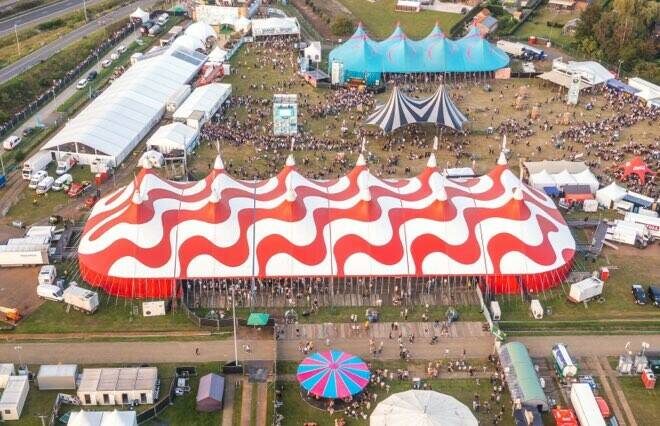
A safe and accessible festival thanks to IoT
Discover the whole setup
The music festival Crammerock attracts 35,000 visitors yearly to Stekene. The organizers use various technologies to ensure that the event runs smoothly and safely.
Anthony De Block is logistics manager. ‘Measuring is knowing’, is the motto of the electromechanics engineer. “Many parameters contribute to a successful and safe festival. If data can help you monitor and optimize processes, you should embrace it.” The organizers first mapped out where technology could benefit them. “Aspects such as CO2 concentration and pressure measurement were a priority in times of COVID, but the wind speed and toilet use also offered the necessary potential,” says Anthony De Block.

Read more
Case Schréder
Smartly controlled public lighting
Schréder, a smart lighting specialist and Codit, an expert in Microsoft Azure, co-developed the new online platform Exedra. This platform allows Schréder customers to manage their own smart lighting data personally.
For many government and town council offices, public lighting is a challenge. Liège-based Schréder’s smart lighting provides a solution to that issue. Schréder’s Jean-Jacques van Gils: “Our aim is to provide solutions in the form of apps, for example, that facilitate better, optimized customer-driven management of public lighting.
Schréder’s smart lighting works with sensors that record temperature, traffic density, or weather conditions. Those sensors then send their data to the online Exedra platform. Customers can use the application to analyze, control, and manage all the data in order to maximize their lighting network’s efficiency. The platform is a Codit solution.


